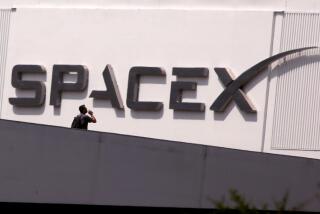Exit Plan: Follow Nissan
Linda Johnston shed no tears as she flew away this month from the place that had been home for all 43 years of her life.
The administrative assistant for Nissan North America is among 550 headquarters employees who opted to stick with the company as it relocates from its freeway-bound campus in Gardena to the hill country of middle Tennessee, just south of Nashville.
The exodus began last month and is expected to wind up by today, when only a skeleton maintenance crew will be left at Nissanâs 14-building complex on 40 acres near the junction of the 405 and 110 freeways.
About 750 of Johnstonâs co-workers decided to quit their jobs rather than head for the hills. Many were anchored by family ties, some by the draw of the Southern California lifestyle and others simply by fear of the unknown.
Their departure creates a challenge for their old boss, Nissan Motor Co. Chief Executive Carlos Ghosn, as he pursues a proposed alliance with current partner Renault and General Motors Corp. As Nissan races to replace nearly 60% of its headquarters staff, including 13 of 60 top executives who opted to retire or change employers, some industry analysts have worried about a âbrain drainâ at the company.
At the same time, other observers laud Japanâs No. 2 automaker for keeping as many workers as it has, crediting its choice of Tennessee as a fresh alternative to California and a quality of life that may have lost some of its luster.
Johnston, for her part, says she was thrilled.
âI wanted to move. I was frustrated with L.A. Itâs too crowded, thereâs not enough greenery. It was overwhelming. Thereâs so much stress there. I wanted to get out,â she said in a telephone interview from Nissanâs temporary headquarters in the landmark BellSouth Building in downtown Nashville.
Nissan will call Nashville home for about two years until it moves 15 miles south. It is building a $100-million, nine-story headquarters in the newly developing Cool Springs area of Franklin, a suburb founded in 1799 and noted for its antebellum downtown. Its Confederate cemetery marks the site of the last major battle of the Civil War.
Some of those transferring with Johnston to Tennessee found the decision more difficult.
âThere were a lot of sleepless nights, and Iâm really going to miss Southern California,â said Orth Hedrick, 44, a product manager who has worked on Nissanâs Versa subcompact, Sentra sedan and Quest minivan. âBut it came down to a choice between giving up a place I love or a job I love, and the job won.â
Whatever workersâ reasons for going, Nissanâs 42% employee retention rate sends a message to businesses in California: The Golden Stateâs charms arenât what they used to be.
âThere is a bit of that attitude, especially at the state level, that California is just so great that no one would ever want to leave -- that its natural features, creative services and the quality of its higher education system are so good theyâre enough to get the job done,â said Greg Whitney, vice president of business development for the Los Angeles County Economic Development Corp.
Nissanâs experience argues against that conceit, he said. Typically, a company moving its headquarters 2,000 miles, especially from a major urban center to a smaller, more rural region, is fortunate to hang on to 25% to 30% of its workforce.
These days, though, Californiaâs schools are no longer among the nationâs best, its infrastructure is deteriorating from a lack of funds for upkeep, and an ever-increasing population is crowding its cities and jamming its highways.
Companies usually decide to move for one reason -- to save money -- whereas employees have individual, often complex reasons, Whitney said.
âBut the world is becoming more homogenized,â he said, âand the fact that Starbucks are everywhere helps make moving a lot easier these days.â
With the move, Nissan is ending a 48-year run as a Southern California company.
Its first sales here were made by Yutaka Katayama, now 96 and retired in Japan. He set out from Japan for the U.S. in 1958 with a few dollars in his pocket to peddle a boxy, underpowered car called the Datsun 210.
He would leave the tiny model with used-car dealers, who found that it was cheap enough and sufficiently reliable to entice customers. Katayama -- who later won renown in sports car circles as âMr. K,â father of the Nissan Z -- eventually patched together a network of dealerships. Sales took off with the arrival of the Datsun 510 sedan in 1968 and the 240Z in 1969.
Nissan has grown steadily from that modest beginning, selling slightly more than 1 million cars and trucks in the U.S. last year and 511,768 through the first six months of this year. It has surpassed Honda Motor Co. in global sales and trails only Toyota Motor Corp. among Japanese automakers. The U.S. accounts for a third of Nissanâs global sales and half its operating profit.
Winning over Nissan has been a boon to Tennessee and in particular Nashville. Shop, bank and office windows downtown are sporting âNashville Welcomes Nissanâ signs as the automakerâs staff moves in. Franklin Mayor Tom Miller said his city had started planning a big welcoming celebration for 2008, when Nissan takes up permanent residence there.
The state has successfully wooed other major corporations, including eight headquarters to Nashville in the last 30 months. But Nissan is a global entity âthat has put Tennessee on the radar screens of a lot of companies, in Europe and Asia too, not just in the U.S.,â said state economic development director Matt Kisber.
For CEO Ghosn and his team, Tennessee offered obvious advantages.
Nissanâs major North American manufacturing facilities are in the state and in neighboring Mississippi. The company can cut costs by consolidating its major functions in one region. And sealing the deal: Tennessee offered a $197-million relocation package as a lure while California could counter with only $20 million in inducements, mainly job training assistance and reduced utility fees.
The move is part of the continuing overhaul launched by Ghosn, a veteran of the French auto industry whom Renault sent to Tokyo in 1999 to rescue Nissan from insolvency. Renault acquired a controlling interest in Nissan and gave the executive free rein to remake the Japanese automaker.
Ghosn dismantled Nissanâs tradition-bound Japanese management system, shuttered plants, ended the practice of lifetime employment and severed partnerships with suppliers that were based on friendships and family ties rather than on competitive pricing. He turned things around in less than two years but has never relaxed his cost-cutting efforts.
Moving Nissanâs North American administrative headquarters -- including its financial, marketing, product planning and engineering staffs -- to Franklin will place the operation within a 40-minute drive of the companyâs North America manufacturing headquarters in Smyrna, Tenn., where Nissan has invested more than $2 billion and employs 6,500 workers.
California employees who chose to make the move are relocating to an area that has an international airport and 19 colleges, including Vanderbilt University. It is within 700 miles of 60% of the U.S. population and is closer to Nissan operations in Canada and Mexico than is the Gardena site.
âThis whole Nashville area is about where Atlanta was 20 years ago, so people moving here now are getting in on the front end of a big boom,â said Grant Hammond, a broker and relocation specialist with Cindy Jasperâs HummerHomes Realtors in Franklin.
For single mother Johnston and her three daughters, ages 11 to 17, the move was a chance to start a new life in vastly improved surroundings.
In Torrance, her family was squeezed into a 1,064-square-foot home she rented from her mother, who has moved to Tennessee as well.
In Franklin, the family was able to trade up to a 4,000-square-foot, two-story, all-brick home with five bedrooms, four bathrooms and a quarter-acre lot. Instead of power lines and neighborsâ fences, the views are of tree-covered hillsides.
And at $449,000, Johnston said, the house cost $217,000 less than what her mom received for selling the Torrance place.
What made the case for Hedrick, the product manager, was turning off Interstate 65 and onto the Cool Springs offramp âand realizing that you could really be anywhere USA.â
âThereâs a great, big regional shopping mall, and most of the stores and restaurants are the same ones we see in California,â he said. âYet a few miles away youâre in downtown and thereâs lots of local color too.â
Hedrick said several visits during the winter also helped him and life partner Kevin Rogers make the decision to move to Franklin -- as it turns out, to the same development as Johnston -- from the Fairfax Avenue area of Los Angeles.
âWeâre giving up dim sum and first-run independent films, 24-hour grocery stores. Thereâll be no more morning coffee at the Newsroom with Robert Downey Jr. sitting at the next table, and weâll miss sunset walks along the strand in Manhattan Beach,â Hedrick said.
âBut weâre going to a place with spectacular scenery, rivers that donât have concrete banks, much more affordable housing, a lot less traffic and pretty close proximity to a lot of major cities, like Atlanta and Chicago, that are just a few hours away by car or an hour by plane.â
Hedrick said he and Rogers -- who quit his job as a scheduler and planner for a small manufacturer -- were a little apprehensive about moving because of Tennesseeâs location in the heart of the so-called Bible Belt.
âBut we have been there a lot now, and weâve found the people to be -- I know it sounds trite -- but, well, just really friendly.â






